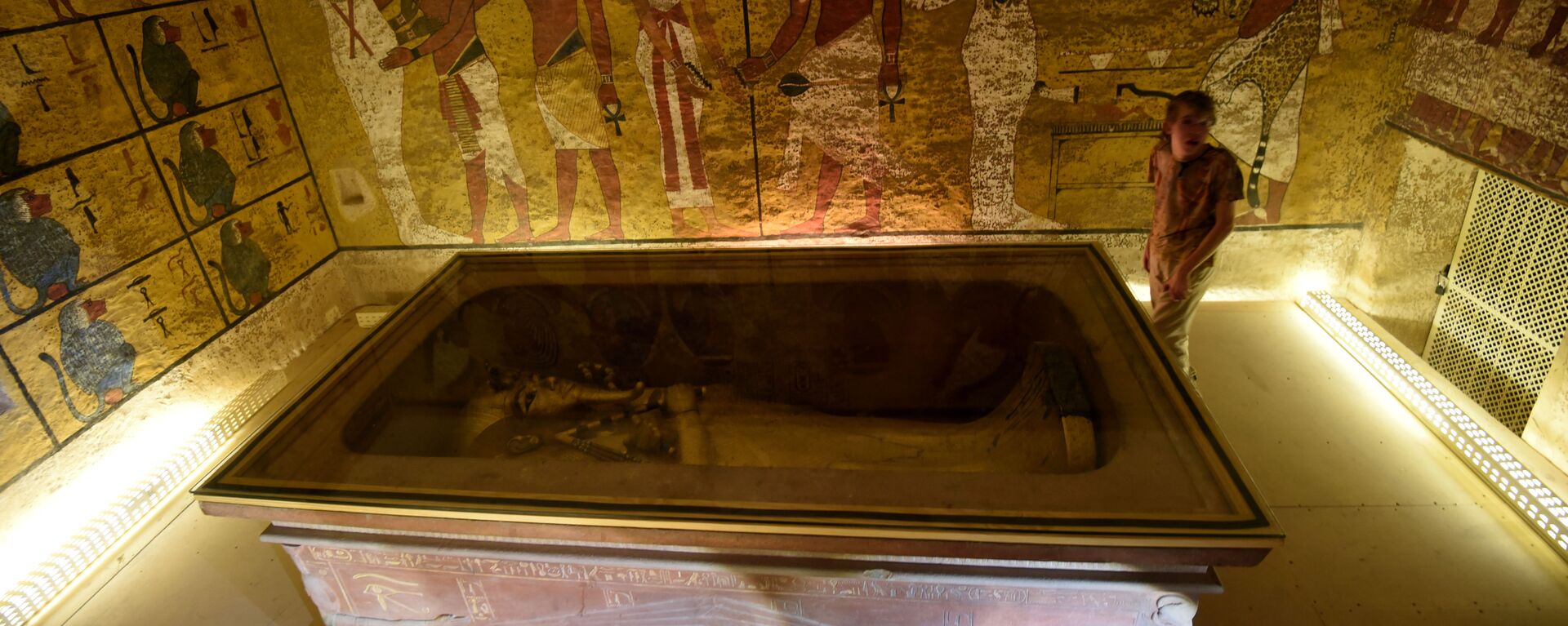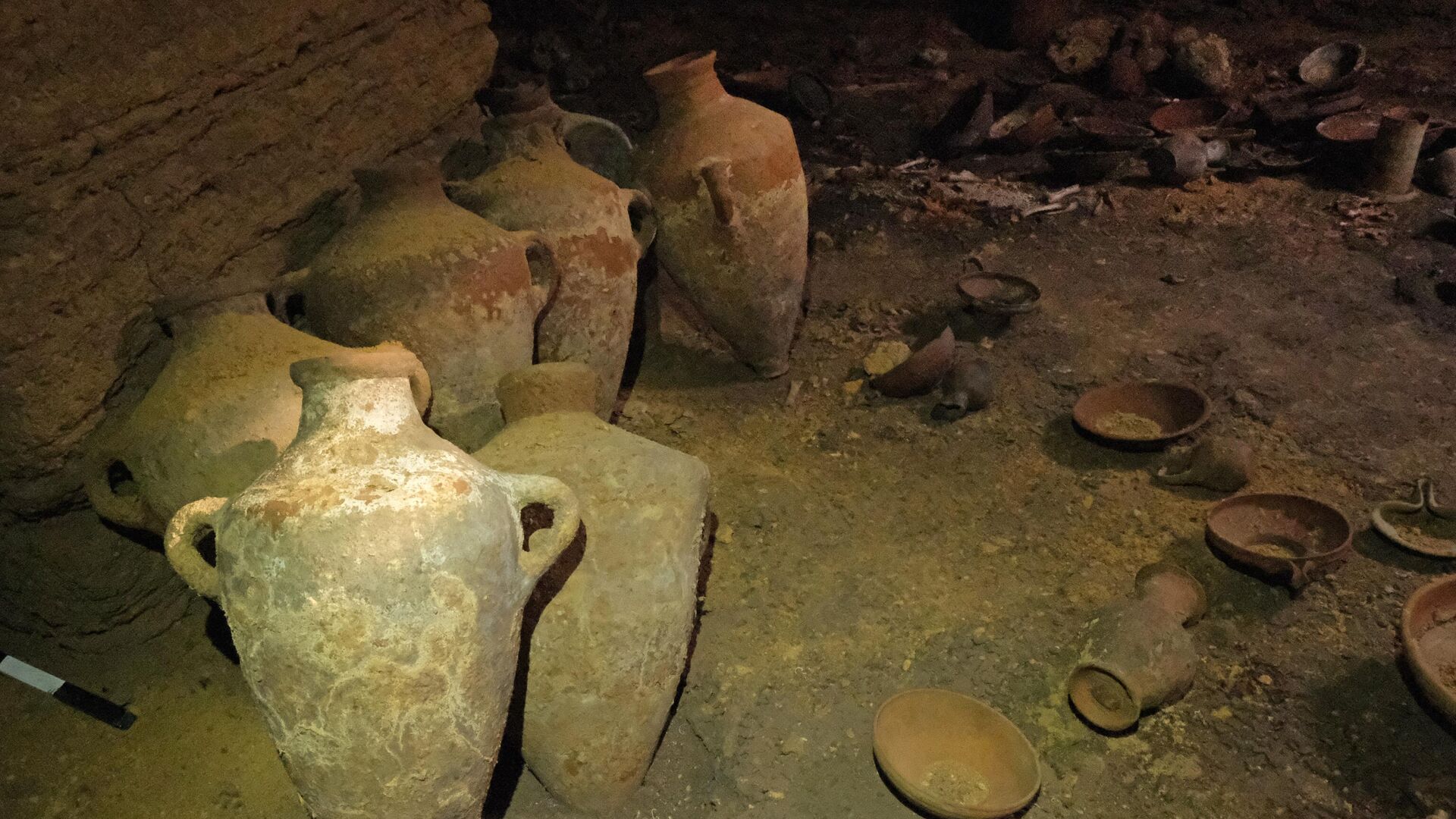https://sputnikglobe.com/20220919/archeologists-find-untouched-burial-cave-dating-to-pharaoh-ramesses-ii-era-over-3300-years-ago-1100940142.html
Archeologists Find Untouched Burial Cave Dating to Pharaoh Ramesses II Era, Over 3,300 Years Ago
Archeologists Find Untouched Burial Cave Dating to Pharaoh Ramesses II Era, Over 3,300 Years Ago
Sputnik International
The discoveries are related to the time of ancient Egypt's pharaoh Ramesses II, of 19th Dynasty of Egypt at the end of the Bronze Age, who ruled over Canaan... 19.09.2022, Sputnik International
2022-09-19T03:10+0000
2022-09-19T03:10+0000
2025-04-07T11:04+0000
egypt
ancient egypt
pharaonic era
pharaoh
ramses the great
cave
archeology
archaeology
israel
viral news
https://cdn1.img.sputnikglobe.com/img/07e6/09/13/1100940627_0:93:3073:1821_1920x0_80_0_0_a3bf28ab2257d86c6217d5da072109b8.jpg
A group of Israeli archaeologists recently discovered an approximately 3,300-year-old burial cave since-described as a "once-in-a-lifetime" find, national media reported on Sunday.The team discovered ceramic fragments and bronze artifacts on Tuesday that belonged to the times of the ancient Egyptian king who died in 1213 BC, according to a statement released by the Israel Antiquities Authority (IAA).The team discovered the unexplored 3,300-year-old cave in the Palmachim National Park, just south of Tel Aviv. The vast majority of objects that have been found date to the Late Bronze Age, either just after or during the rule of Ramesses II, who is well-known in the Bible. When a rock moved during construction works, shedding light on an entire burial assembly about 2.5 meters below, the cave was discovered. Inspectors from the IAA were called to the spot, and a video in Hebrew of an initial investigation of a location where no one had set foot in more than three thousand years captures their delight.The cave also included footed chalices, cooking pots, storage jars, lanterns, and bronze arrowheads or spearheads and bowls, some of which were painted red and contained bones. The items were funeral offerings meant to accompany the departed on their final trip to the afterlife.The finding of perhaps several skeletons in the corner of the square-shaped cave at the video's conclusion brings the suspense to a crescendo.According to Yannai, the importation of vessels from Lebanon, Syria, and Cyprus was typical for burial assemblages at the time. Numerous pottery vessels of all sizes and shapes were discovered, including cooking pots, jugs, deep and shallow bowls. Other biological materials, such as a probable quiver that contained a variety of the metal arrowheads or spearheads discovered in the cave, may have decomposed over the millennia.These are not the area's first archaeological discoveries; there are also remnants of settlements from the Muslim era at the well-known beach park. The park is home to an authorized archaeology trail that honors, among other buildings, an old stronghold that guarded the shore about 3,500 years ago when it was populated by Canaanites, vassals of the governing Egyptians. Archaeologists have intermittently excavated at the location since 1992, and earlier work there revealed a quarry that was active at the time the newly discovered cave was built.Eli Eskozido, the head of IAA, lamented that certain objects were stolen before the resealing was finished."Shortly before the cave was sealed, and despite guarding it, a number of archaeological items were stolen from the cave, and the matter is under investigation,” he said.
https://sputnikglobe.com/20191130/ancient-egyptian-bombshell-its-now-known-who-made-almighty-king-ramses-tomb-survive-until-now-1077444695.html
https://sputnikglobe.com/20211012/fine-wine-archaeologists-discover-worlds-biggest-byzantine-winery---photos-videos-1089850744.html
egypt
israel
Sputnik International
feedback@sputniknews.com
+74956456601
MIA „Rossiya Segodnya“
2022
News
en_EN
Sputnik International
feedback@sputniknews.com
+74956456601
MIA „Rossiya Segodnya“
Sputnik International
feedback@sputniknews.com
+74956456601
MIA „Rossiya Segodnya“
egypt, ancient egypt, pharaonic era, pharaoh, ramses the great, cave, archeology, archaeology, israel, viral news
egypt, ancient egypt, pharaonic era, pharaoh, ramses the great, cave, archeology, archaeology, israel, viral news
Archeologists Find Untouched Burial Cave Dating to Pharaoh Ramesses II Era, Over 3,300 Years Ago
03:10 GMT 19.09.2022 (Updated: 11:04 GMT 07.04.2025) Kirill Kurevlev
Managing Editor
The discoveries are related to the time of ancient Egypt's pharaoh Ramesses II, of 19th Dynasty of Egypt at the end of the Bronze Age, who ruled over Canaan, which roughly corresponds to present-day Israel and the Palestinian territories.
A group of Israeli archaeologists recently discovered an approximately 3,300-year-old burial cave since-described as a "once-in-a-lifetime" find, national media
reported on Sunday.
The team discovered ceramic fragments and bronze artifacts on Tuesday that belonged to the times of the ancient Egyptian king who died in 1213 BC, according to a statement released by the Israel Antiquities Authority (IAA).
The team discovered the unexplored 3,300-year-old cave in the Palmachim National Park, just south of Tel Aviv. The vast majority of objects that have been found date to the Late Bronze Age, either just after or during the rule of Ramesses II, who is well-known in the Bible.
When a rock moved during construction works, shedding light on an entire burial assembly about 2.5 meters below, the cave was discovered. Inspectors from the IAA were called to the spot, and a video in Hebrew of an initial investigation of a location where no one had set foot in more than three thousand years captures their delight.
The cave also included footed chalices, cooking pots, storage jars, lanterns, and bronze arrowheads or spearheads and bowls, some of which were painted red and contained bones. The items were funeral offerings meant to accompany the departed on their final trip to the afterlife.
The finding of perhaps several skeletons in the corner of the square-shaped cave at the video's conclusion brings the suspense to a crescendo.
"This is a once-in-a-lifetime find! It’s not every day that you walk onto an Indiana Jones set — a cave with tools on the floor that haven’t been touched in 3,300 years,” IAA Bronze Age expert Eli Yannai said in a release.

30 November 2019, 13:37 GMT
According to Yannai, the importation of vessels from Lebanon, Syria, and Cyprus was typical for burial assemblages at the time. Numerous pottery vessels of all sizes and shapes were discovered, including cooking pots, jugs, deep and shallow bowls.
Other biological materials, such as a probable quiver that contained a variety of the metal arrowheads or spearheads discovered in the cave, may have decomposed over the millennia.
"The finds in the cave date to the thirteenth century BCE (Late Bronze Age IIB). [...] The cave may furnish a complete picture of the Late Bronze Age funerary customs,” Yannai added. "In this period, in the long reign of the Nineteenth Egyptian Dynasty Pharaoh Rameses II, the Egyptian Empire controlled Canaan, and the Egyptian administration provided secure conditions for extensive international trade".
These are not the area's first archaeological discoveries; there are also remnants of settlements from the Muslim era at the well-known beach park. The park is home to an authorized archaeology trail that honors, among other buildings, an old stronghold that guarded the shore about 3,500 years ago when it was populated by Canaanites, vassals of the
governing Egyptians. Archaeologists have intermittently excavated at the location since 1992, and earlier work there revealed a quarry that was active at the time the newly discovered cave was built.
"The fact that the cave was sealed, and not looted in later periods, allows us, with the scientific means available today, to extract a great deal of information from the objects and materials that survived in them, and which are not visible to the eye, including organic materials. The cave can provide us with a complete picture of burial customs in the Late Bronze Age,” Yannai said.
Eli Eskozido, the head of IAA, lamented that certain objects were stolen before the resealing was finished.
"Shortly before the cave was sealed, and despite guarding it, a number of archaeological items were stolen from the cave, and the matter is under investigation,” he said.

12 October 2021, 04:47 GMT



